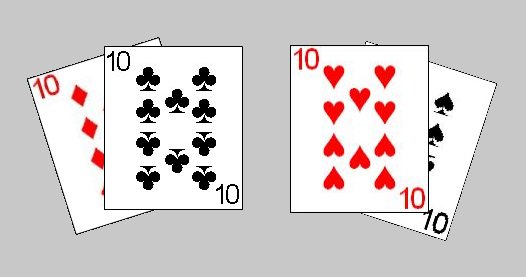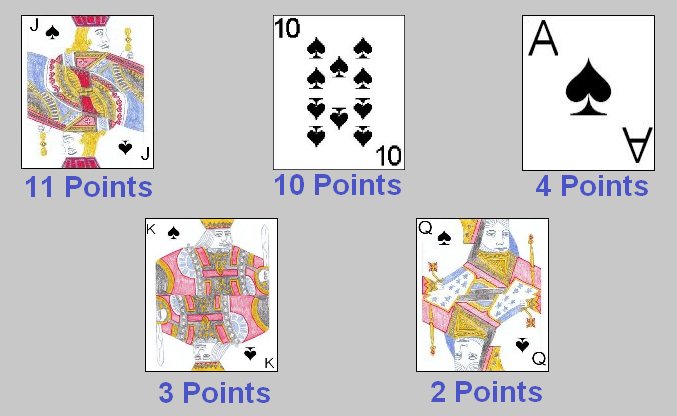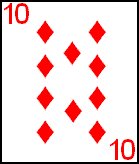 Although having Whist in the name, Scotch or Scottish Whist is more related to the Skat family of games (being of Germanic origin) than it is to Whist. This game is also commonly called Catch the Ten due to the players attempts to capture high point value trump cards in tricks, such as the ten.
Although having Whist in the name, Scotch or Scottish Whist is more related to the Skat family of games (being of Germanic origin) than it is to Whist. This game is also commonly called Catch the Ten due to the players attempts to capture high point value trump cards in tricks, such as the ten.Scotch Whist is designed to be played by from two to eight participants. The format of the game and style of play is dependent on if there are an odd or even number of players:
For an odd number of players, there are no partnerships and each player plays for himself and may sit anywhere around the table.
With two players, each player also plays for himself and the play alternates between each player who should sit across from each other at the table.
If there are an even number of players (more than two), the players will be divided into a number of two person partnerships. To determine these partnerships, each player should cut a card from a shuffled, face down deck. The two highest cards form the first partnership, the two next highest the next partnership and so on. Any players who draw cards of the same denomination should replace the card and draw another, continuing this until there are no tied cards.
When four play, the partners should sit directly across from each other such as to alternate play between members of each partnership. For six players, the members of a particular partnership should sit evenly around the table such that two opponents sit between the two partners. For eight players, the members of the partnership should sit such that there are three opponents between each member of a partnership.
Scotch Whist is usually played with a deck of 36 cards, which consists of a deck consisting of 4 each (one of each suit) of the following card denominations: Ace, King, Queen, Jack, 10, 9, 8, 7, 6. The ranking of these cards in any non-trump suit is as follows (from highest to lowest): Ace, King, Queen, Jack, 10, 9, 8, 7, 6. However, in the trump suit, the ranking is slightly different (in descending order): Jack, Ace, King, Queen, 10, 9, 8, 7, 6. To ensure the number of cards will deal out evenly to the number of players, cards are removed from the deck for differing numbers of players. When the game is being played by 5 or 7 players, one card is removed (usually the 6 of spades). When played by 8, all four sixes are removed from the deck.
The object of Scotch Whist is to win tricks, particularly those containing high scoring values (the top trump cards). The scoring value of specific cards won in tricks is shown in a chart found further below.
For convenience, the following table shows the number of players, play style, additional cards removed from the reduced deck and the minimum number cards needed before earning points for tricks captured (described in the game scoring section below).
| Number of Players | Play Style | Cards Dealt | Minimum Needed for Card Score | Cards Removed |
|---|---|---|---|---|
| 2 | Individual Play | 18 | 18 Individually | None |
| 3 | Individual Play | 12 | 12 Individually | None |
| 4 | 2 Partnerships of 2 Players each | 9 | 18 Cards for the Partnership | None |
| 5 | Individual Play | 7 | 7 Individually | Six of Spades |
| 6 | 3 Partnerships of 2 Players each | 6 | 12 Cards for the Partnership | None |
| 7 | Individual Play | 5 | 5 Individually | Six of Spades |
| 8 | 4 Partnerships of 2 Players each | 4 | 8 Cards for the Partnership | All sixes |
The determination of the first dealer and seating positions can also be done with each player drawing a card from a shuffled deck. Any players drawing cards of the same rank should draw again, and continue drawing until they draw a card that no other player has yet drawn. The players then seat themselves at the table in the order of card ranking from high to low. A player may select any empty seat. The player who draws the highest card of all becomes the first dealer. In the partnership versions, the two highest drawn cards become partners, the next highest two drawn the next partners and so on. The partners should sit at the table in such a way that a player has an opponent on either side of him in the order of play.
After the partnerships and seating positions are determined, the players should also perform a cut for determination of the first dealer, with the player cutting the highest card earning that privilege.
Once the first dealer is determined he should then deal the cards, face down around the table in a clockwise direction around the table, one by one. The last card is placed in the center of the table, which determines the trump suit for the hand. This card belongs to the hand of the dealer, but he must ensure all players have had the opportunity to view it before adding it to his hand which he does just before playing a card to the first trick.
The player to the dealer's immediate left leads the first card (any card of his choosing) to the first trick. Each player, in a clockwise direction then plays a card to the trick. Each player must play a card of the same suit of the card first led to the trick if he has one. If he does not have a card of this same suit, he may play any card, including a card of the trump suit.
The highest trump card played to a trick wins the trick. If no trump cards have been played to the trick, the highest card of the original suit led to the trick wins the trick. One of the players in the partnership should gather in all the tricks won by his side. At the end of the hand, the partnerships score points for cards won in tricks. For each card the partnership has captured in total MORE than the cards they were originally dealt in the hand, they score 1 point. As an example, in a four player partnership version, each player would receive 9 cards for a total of 18 for the partnership. For each card above 18 that the partnership was able to capture (if any) they would earn one point. In individual play (non-partnership version) a player would individually earn one point for each card they captured above the number that the player was originally dealt. In addition to these points, players or partnerships score points for certain high cards of the trump suit won in tricks. The following chart shows these cards and the value of each:
|

|
The first partnership or individual (depending on the style played) to score 41 or more points at the end of a hand is declared the winner of the game. The player to the immediate left of the previous dealer deals the next hand. If two or more partnerships or players reach 41 or above at the end of a hand, the scoring should be calculated in the following specific order to determine which partnership or player actually reached 41 points first; Ten of trumps, Points for tricks won, Ace of trumps, King of trumps, Queen of trumps, Jack of trumps.
